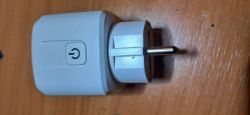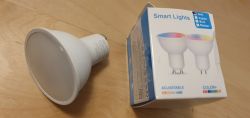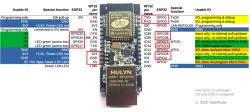This is a short teardown of the Aubess Mini Smart Switch 16A which is based on BK7231N and it uses a custom PCB ,so no Tuya module in there.
Brand: Aubess
Model: Aubess Mini Smart Switch 16A
Chip: BK7231N
Vendor (that's exactly where i bought it): https://www.aliexpress.com/item/1005003631131323.html? <- it's the kind of seller that ask for extra shipping fees,so not really recommend it
The switch is very easy to open so i wont go into details,but remember,this device it's using high voltage,so make sure it's not connected to the mains.Also ,i took pictures only of the relevant parts.
![[BK7231N] Aubess Mini Switch 16A [BK7231N] Aubess Mini Switch 16A](https://obrazki.elektroda.pl/6209806600_1660573904_thumb.jpg)
![[BK7231N] Aubess Mini Switch 16A [BK7231N] Aubess Mini Switch 16A](https://obrazki.elektroda.pl/1889386300_1660573903_thumb.jpg)
![[BK7231N] Aubess Mini Switch 16A [BK7231N] Aubess Mini Switch 16A](https://obrazki.elektroda.pl/7955118900_1660573904_thumb.jpg)
![[BK7231N] Aubess Mini Switch 16A [BK7231N] Aubess Mini Switch 16A](https://obrazki.elektroda.pl/3028739200_1660573912_thumb.jpg)
![[BK7231N] Aubess Mini Switch 16A [BK7231N] Aubess Mini Switch 16A](https://obrazki.elektroda.pl/1820770400_1660573918_thumb.jpg)
Requirements:
USB to TTL adapter
Soldering Iron
Soldering skils (not pro level,but still...)
Magnifying glass or microscope are a plus
Steady hands
Wiring: -> Check the attached picture to locate the pins on the PCB
( PCB ) GND - > GND ( TTL )
( PCB ) TX - > RX ( TTL )
( PCB ) RX - > TX ( TTL )
( PCB ) CEN/EN -> GND ( PCB ) <- CEN must be short to GND only for a second,in order to boot the chip in flash mode
Flashing: -> In my case the 3.3v pin was not required at all.
1) Connect GND,RX and TX to the USB TTL then attach the TTL adapter to the PC.
2) Open BKwriter 1.60 and set the baudrate (see attached picture)
3) Try to read the flash (if it fails ,then short CEN to GND for a second then try again) <- this will create a backup of the original firmware
4) After BKwriter has finished the backup,you can proceed with the OpenBeken firmware flashing ,just follow the guide from https://github.com/openshwprojects/OpenBK7231T_App/blob/main/README.md#flashing-for-bk7231n
5) After flashing Openbeken you should be able to find the quick configuration (i've sent a PR for that) for this device in ; http://[Device_IP] > Config < Quick Config
Basic Informations:
Brand: Aubess
Model: Aubess Mini Smart Switch 16A
Chip: BK7231N
Vendor (that's exactly where i bought it): https://www.aliexpress.com/item/1005003631131323.html? <- it's the kind of seller that ask for extra shipping fees,so not really recommend it
Teardown Photos
The switch is very easy to open so i wont go into details,but remember,this device it's using high voltage,so make sure it's not connected to the mains.Also ,i took pictures only of the relevant parts.
![[BK7231N] Aubess Mini Switch 16A [BK7231N] Aubess Mini Switch 16A](https://obrazki.elektroda.pl/6209806600_1660573904_thumb.jpg)
![[BK7231N] Aubess Mini Switch 16A [BK7231N] Aubess Mini Switch 16A](https://obrazki.elektroda.pl/1889386300_1660573903_thumb.jpg)
![[BK7231N] Aubess Mini Switch 16A [BK7231N] Aubess Mini Switch 16A](https://obrazki.elektroda.pl/7955118900_1660573904_thumb.jpg)
![[BK7231N] Aubess Mini Switch 16A [BK7231N] Aubess Mini Switch 16A](https://obrazki.elektroda.pl/3028739200_1660573912_thumb.jpg)
![[BK7231N] Aubess Mini Switch 16A [BK7231N] Aubess Mini Switch 16A](https://obrazki.elektroda.pl/1820770400_1660573918_thumb.jpg)
Flashing OpenBeken firmware
Requirements:
USB to TTL adapter
Soldering Iron
Soldering skils (not pro level,but still...)
Magnifying glass or microscope are a plus
Steady hands
Wiring: -> Check the attached picture to locate the pins on the PCB
( PCB ) GND - > GND ( TTL )
( PCB ) TX - > RX ( TTL )
( PCB ) RX - > TX ( TTL )
( PCB ) CEN/EN -> GND ( PCB ) <- CEN must be short to GND only for a second,in order to boot the chip in flash mode
Flashing: -> In my case the 3.3v pin was not required at all.
1) Connect GND,RX and TX to the USB TTL then attach the TTL adapter to the PC.
2) Open BKwriter 1.60 and set the baudrate (see attached picture)
3) Try to read the flash (if it fails ,then short CEN to GND for a second then try again) <- this will create a backup of the original firmware
4) After BKwriter has finished the backup,you can proceed with the OpenBeken firmware flashing ,just follow the guide from https://github.com/openshwprojects/OpenBK7231T_App/blob/main/README.md#flashing-for-bk7231n
5) After flashing Openbeken you should be able to find the quick configuration (i've sent a PR for that) for this device in ; http://[Device_IP] > Config < Quick Config
Cool? Ranking DIY








![[BK7231N] Aubess Mini Switch 16A [BK7231N] Aubess Mini Switch 16A](https://obrazki.elektroda.pl/1309738100_1660641296_thumb.jpg)
![[BK7231N] Aubess Mini Switch 16A [BK7231N] Aubess Mini Switch 16A](https://obrazki.elektroda.pl/6581801300_1667148345_thumb.jpg)
![[BK7231N] Aubess Mini Switch 16A [BK7231N] Aubess Mini Switch 16A](https://obrazki.elektroda.pl/9000012400_1668112252_thumb.jpg)
![[BK7231N] Aubess Mini Switch 16A [BK7231N] Aubess Mini Switch 16A](https://obrazki.elektroda.pl/7129545700_1668164234_thumb.jpg)
![[BK7231N] Aubess Mini Switch 16A [BK7231N] Aubess Mini Switch 16A](https://obrazki.elektroda.pl/4398794800_1669200695_thumb.jpg)
![[BK7231N] Aubess Mini Switch 16A [BK7231N] Aubess Mini Switch 16A](https://obrazki.elektroda.pl/9887890100_1669202367_thumb.jpg)
![[BK7231N] Aubess Mini Switch 16A [BK7231N] Aubess Mini Switch 16A](https://obrazki.elektroda.pl/7041097400_1669204419_thumb.jpg)
![[BK7231N] Aubess Mini Switch 16A [BK7231N] Aubess Mini Switch 16A](https://obrazki.elektroda.pl/2969832700_1669206667_thumb.jpg)
![[BK7231N] Aubess Mini Switch 16A [BK7231N] Aubess Mini Switch 16A](https://obrazki.elektroda.pl/1339698800_1669215876_thumb.jpg)
![[BK7231N] Aubess Mini Switch 16A [BK7231N] Aubess Mini Switch 16A](https://obrazki.elektroda.pl/4126317000_1673822763_thumb.jpg)
![[BK7231N] Aubess Mini Switch 16A [BK7231N] Aubess Mini Switch 16A](https://obrazki.elektroda.pl/3125810200_1674576432_thumb.jpg)